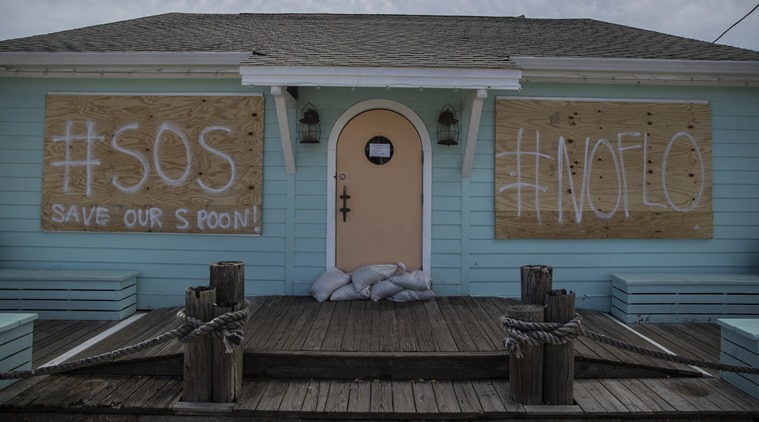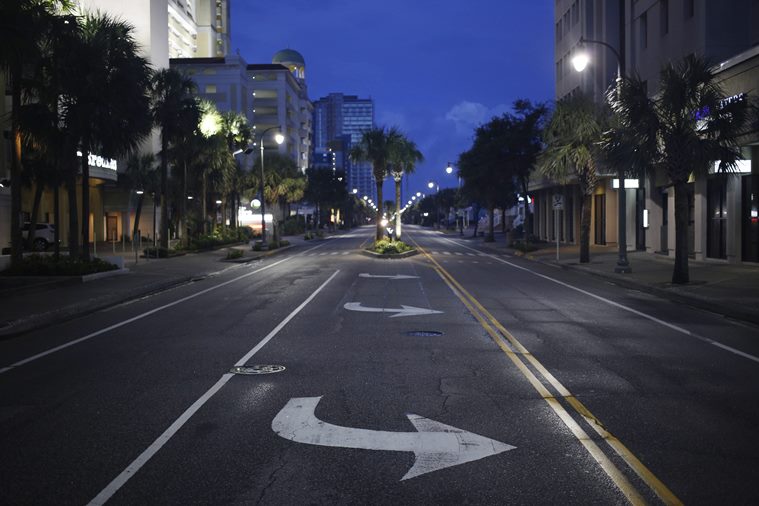 Officials in South Carolina, North Carolina and Virginia are imploring residents and visitors to evacuate coastal areas ahead of Hurricane Florence, with more than one million expected to flee. The Category 4 storm is predicted to make landfall Thursday night, with tropical storm-force winds arriving by Thursday morning. (Victor J. Blue/The New York Times)
Officials in South Carolina, North Carolina and Virginia are imploring residents and visitors to evacuate coastal areas ahead of Hurricane Florence, with more than one million expected to flee. The Category 4 storm is predicted to make landfall Thursday night, with tropical storm-force winds arriving by Thursday morning. (Victor J. Blue/The New York Times)
Hours before Hurricane Florence is expected to begin its assault on the Carolinas, officials warned of fierce winds, catastrophic flooding, storm surges up to 13 feet and widespread power failures as they urged residents to get out while there was still time.
Florence, now a Category 2 storm packing sustained winds of up to 110 mph, is expected to pummel the region for days, starting with heavy winds along the coast on Thursday morning. The hurricane will then gather strength and spread inland as the center of the storm edges toward the coast on Friday afternoon, bringing torrential rainfall of up to 40 inches that will continue through Saturday and Sunday.
The storm was predicted to slow and the eye could stall just offshore, battering the coast with high waves and dropping as much as 20 to 40 inches of rain in flood-prone coastal areas.
The center of the storm was in the Atlantic Ocean about 335 miles from Wilmington, North Carolina, on Wednesday evening, the National Hurricane Center said. It was forecast to crawl toward shore on Thursday and Friday, and move slowly along the coastline through Saturday.
Officials in South Carolina said they were unnerved to learn that the projected path of the hurricane had veered south. Gov. Henry McMaster said Wednesday that 300,000 people in the state had evacuated.
Parts of the Carolinas could experience hurricane-force winds for 24 hours or more, said Jeff Byard, associate administrator for response and recovery at the Federal Emergency Management Agency.
“This is not going to be a glancing blow,” he said. “This is not going to be one of those storms that hit and move out to sea. This is going to be a Mike Tyson punch to the Carolina coast.”
As Hurricane Florence stared down at the Carolina coast, many residents were making last-minute decisions about whether to evacuate or ride the storm out.
 With millions of coastal residents either on the move or hunkering down anxiously in place, Hurricane Florence surged toward North Carolina on Wednesday, tracing an unusual path that could lead to tremendous destruction — especially if the immense storm dumps enormous amounts of rain as it moves inland. (Luke Sharrett/The New York Times)
With millions of coastal residents either on the move or hunkering down anxiously in place, Hurricane Florence surged toward North Carolina on Wednesday, tracing an unusual path that could lead to tremendous destruction — especially if the immense storm dumps enormous amounts of rain as it moves inland. (Luke Sharrett/The New York Times)
In Carolina Beach, North Carolina, which sits on an exposed barrier island, Mike Patel is selling almost everything in his grocery store at half-price.
“Some of these people are suffering,” he said. “A hurricane is not the time to make things worse for them.”
Automotive and aerospace businesses, major industries in the Carolinas, have slowed or stopped work in anticipation of the storm. Boeing suspended production at its assembly plant in North Charleston, South Carolina, at noon on Tuesday.